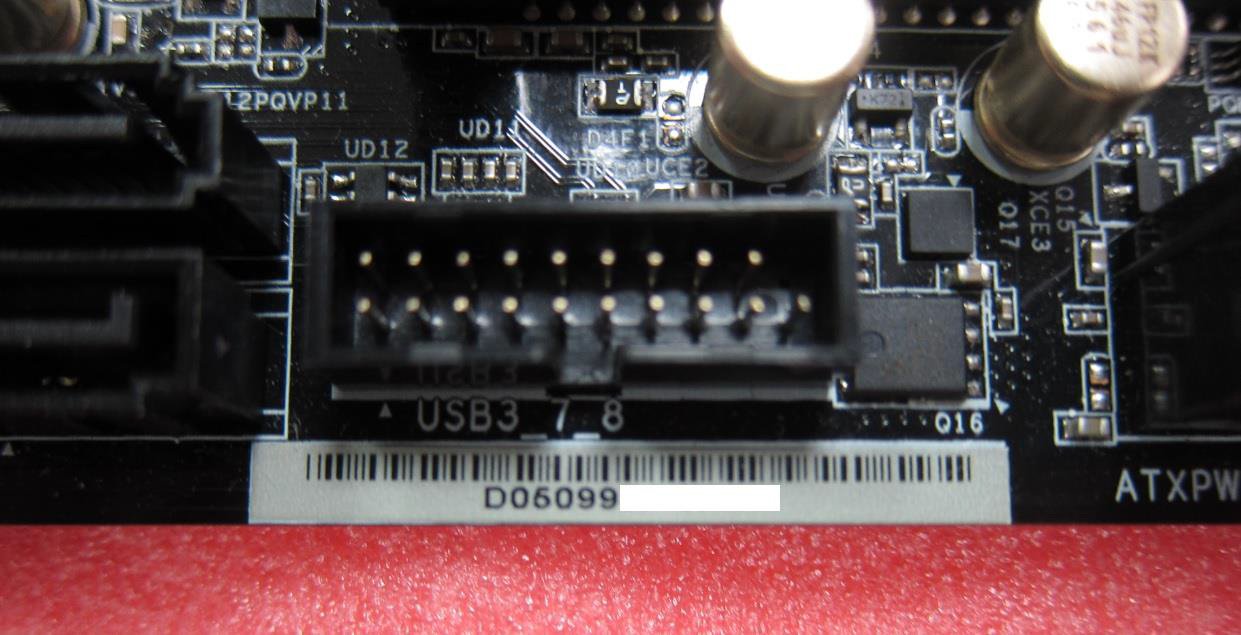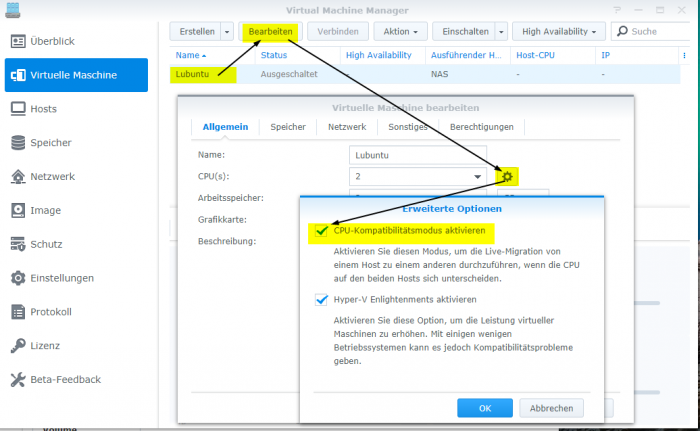-
Posts
18 -
Joined
-
Last visited
Posts posted by deklan
-
-
Good to here it's working now :)
-
Hmmmm
Virtualization (Intel VT...) is enabled in BIOS settings?
-
 1
1
-
-
There was the same issue on my DS916+ (ASRock J3455 DSM 6.1)
I had to enable the 'CPU compatibility mode' to boot the VMs
The compatibility feature is no longer for free but you can downgrade to the last beta version of the VM Manager to test it.
https://archive.synology.com/download/Package/spk/Virtualization/2.3.0-8722/
-
- Outcome of the update: SUCCESSFUL
- DSM version prior update: DSM 6.1.7-15284 Update 2
- Loader version and model: Jun's Loader v1.02b - DS916+
- Using custom extra.lzma: NO
- Installation type: BAREMETAL - ASRock J3455-ITX, HP NC110T
- Additional comments: REBOOT REQUIRED
-
Das letzte Update das mir die DSM Systemsteuerung anbietet ist folgendes:
Modellname : DS916+ Installierte DSM-Version : DSM 6.1.7-15284 Update 2 DSM-Version : 2018/07/09
Manuelles Updaten mit folgendem 916+ Update hat 1A geklappt:
-
7 hours ago, IG-88 said:
ähhh, nö ganz bestimmt nicht vom router, die MAC adresse ist die "physische" adresse der netzwerkkarte und die sollte !!! weltweit!!! nicht mehrfach vorhanden sein (so das ziel der vergabe der adressen) was du meinst ist DHCP, die MAC steckt "fest" in der netzwerkarte kann aber per software (treiber) übersteuert werden so das zur kommunikation nicht die in der karte genommen wird sondern die per software festgelegte
das mit dem "weltweit" ist jetzt nicht ganz so wichtig aber mindestes im eignen LAN darf es keine MAC zweifach geben, die netzwerkkarten kommunizieren auf "unterster ebene" mit hilfe dieser mac adresse und wenn die zweimal da ist fühlen sich zwei angesprechen- > ganz schlecht (siehe OSI schichten modell)
Wir reden ja nicht vom OSI Referenzmodel, sondern wo man sich die MAC anzeigen lassen kann und was das Anzeigen angeht, bieten sich nun mal die oberen Schichten an.
Da tut es sowohl der Ablesen vom Aufkleber als auch das Ablesen aus der Router GUI oder was ipconfig oder ip addr von ner Bootdisk auswirft.
An sich hast Du aber vollkommen recht mit dem was Du schreibst.
7 hours ago, Dertourist48 said:Danke das ihr euch die Zeit genommen habt und mir bei meinen Fragen geholfen habt. So einiges ist da schon klarer geworden.
Ich werde mir dann das Netzteil bestellen und hoffe,das alle Teile unversehrt ankommen, damit ich mich dann an den NAS Eigenbau heranwagen kann. Danke erst mal.
Gerne, macht auf jedenfall Spaß die Kiste.
Die 8GB RAM (statt 4) machen mit der Zeit auch Sinn. Spätestens, wenn eine VM darauf läuft

Sinnvoll finde ich noch eine USB 3.x Festplatten-Dockingstation und ein paar 3.5" Festplatten, dann kannst Du wunderbar und ohne großen Aufwand Deine Daten sichern (mit Synology Hyper Backup)
-
Bei ebay gibts noch einige PicoPSUs.
Gute Frage wegen der MAC. Ich hatte meine gleich auf eine gültige Synoligy MAC geändert.
Im Zweifel bekommst Du die MAC über eine Bootdisk oder vom Router.
Bei ASRock "sollte" sie auch auf dem Board stehen. Bspw.

-
Ich habe seit März u.a. System mit DSM 6.1 (916+) und Loader v1.02b am laufen.
Läuft super, nur Hardware Videotranscoding funktioniert nicht. Bei Virtual Machine Manager muss ich die letzte Beta nehmen (kann bei Synology runtergeladen werden), da dort noch der CPU Compatibility Mode kostenlos ist. Die Gehäuse sind beide recht ähnlich und erfüllen den Zweck.
Aber... DSM 6.2.1 mit Loader v1.04b läuft allerdings überhaupt nicht toll (langsam und reboot funktioniert nicht einwandfrei)
Ich bleibe bei DSM 6.1 und falls (irgendwann mal) kein passender Loader für 6.2.1 oder gar 7.0 kommt, dann kaufe ich eben ein neues Board.
Installiert habe ich DSM 6.1, 916+ mit folgender Anleitung:
vid/ pid nimmst Du von dem Stick der in Deiner NAS bleibt und von dem gebootet wird.
mac1 ist die MAC vom J3455
mac2 brauchst Du nur, wenn Du eine zusätzliche Netzwerkkarte einbaust.
System
1x Cooler Master Elite 120 ITX Tower ohne Netzteil schwarz
1x ASRock J3455-ITX SoC So.BGA Dual Channel DDR3 Mini-ITX Retail
1x 8GB (1x 8192MB) HyperX Impact DDR3L-1866 SO-DIMM CL11-11-11 Single
3x 4000GB Seagate IronWolf ST4000VN008 5.900U/min 64MB 3.5" (8.9cm) SATA 6Gb/s
1x USB Stick (x-beliebig, alter USB 2.0 Stick mit 4GB)
(optional 1x 60 GB SSD (alte Crucial SSD als Cache, damit sie nicht in der Ecke liegen muss))
(optional 1x HP NC110T Gigabit Server Adapter)
Netzteil
1x picoPSU-90 DC/DC (90 Watt) Netzteil
1x Salcar 72W Netzteil (12V 6A),Ladegerät
Viel Watt brauchst Du nicht, da die Platten nacheinander anlaufen und dadurch kein Peak entsteht.
Stromsparender ist eine picuPSU
-
12 hours ago, ideasman69 said:
yeah downgrade is possible. just use afudos.exe on a usb boot disk with DOS (but i have one of these as backup)
Thanks, I will try it.
Which afudos version will work?
There are a lot of versions out there with different compatibilities (AMIBIOS8, APTIO) and different parameters.
Google search failed
Update: Update worked fine with AFUDOS 5.07.01 (for Aptio V)
using command:
afudos APLITX1.30 /X /B /P /N
Flashing process took longer than expected but finally everything is fine.
Thanks ideasman!
-
On 11/12/2018 at 10:38 AM, ideasman69 said:
from testing each of the versions on 3 different models with a handful of operating systems - v1.30 is the one i recommend

Do you also recommend to go back from v1.80 to v1.30 (if downgrade is possible)?
Why do you recommend v1.30?
-
Update to 1.8 via USB stick was successfull too (just my picky flatscreen doesn't like the DVI signal anymore, VGA is OK)
I've downloaded 1.7 and 1.8, unzipped them to USB stick and flashed from 1.4 to 1.7 and then from 1.7 to 1.8
I can check TXE FW version later at home.
-
Der Stick wird zum Starten benötigt, dort ist der Bootloader drauf.
-
I can answer the question by my own now.
Yesterday I made a clean installation of DSM 6.2.1-23824 + Juns 1.04b on an empty USB stick and old 500GB HDD.
Installation went fine but everything seems to be slower than usual e.g.
- NFS file copy startet with 110MB/s and finished with 70MB/s (100GB file),
- installation of Lubuntu VM took ~1hr,
- DSM apps start slower than usual
So I will stay on DSM 6.1 for a while.
-
Hello everybody,
I'm using 916+ DSM 6.1 for 6 month now (ASRock J3455-ITX, HP NC110T ) and I am very happy with it.
Only issue I have is that I have to stay on Virtual Machine Manager Beta because I have to set CPU compatibility mode (which is free to use in beta version).
Every few weeks I check this forum and think I have to upgrade to 918+ DSM 6.2.
Then I read some threads with performance issues like copy speed, boot time and so on and I decide to stay on DSM 6.1
So... is there any advantage to upgrade to 918+ DSM 6.2 (except another ~2 years updates and support)?
Is the feeling and performance withe the J3455 board on 918+ DSM6.2 as good as 916+ DSM6.1 now?
What would you do?
Thanks for your feedback
Dennis
-
- Outcome of the update: SUCCESSFUL
- DSM version prior update: DSM 6.1.7-15284 Update 1
- Loader version and model: Jun's Loader v1.02b - DS916+
- Using custom extra.lzma: NO
- Installation type: BAREMETAL - ASRock J3455-ITX, HP NC110T
- Additional comments: REBOOT REQUIRED
-
- Outcome of the update: SUCCESSFUL
- DSM version prior update: DSM 6.1.6 15266 Update 1
- Loader version and model: Jun's Loader v1.02b - DS916+
- Using custom extra.lzma: NO
- Installation type: BAREMETAL - ASRock J3455-ITX, HP NC110T
- Additional comments: REBOOT REQUIRED before and after. Kept getting "Unknown Error 21" until I reboot before it would update.
-
- Outcome of the update: SUCCESSFUL
- DSM version prior update: DSM 6.1.6-15266
- Loader version and model: Jun's Loader v1.02b - DS916+
- Using custom extra.lzma: NO
- Installation type: BAREMETAL - ASRock J3455-ITX, HP NC110T
- Additional comments: NO REBOOT REQUIRED



DSM 6.2 Loader
in Loaders
Posted
Does it make any sence to test it on 3455-itx after test was not successfull on 4205-itx?